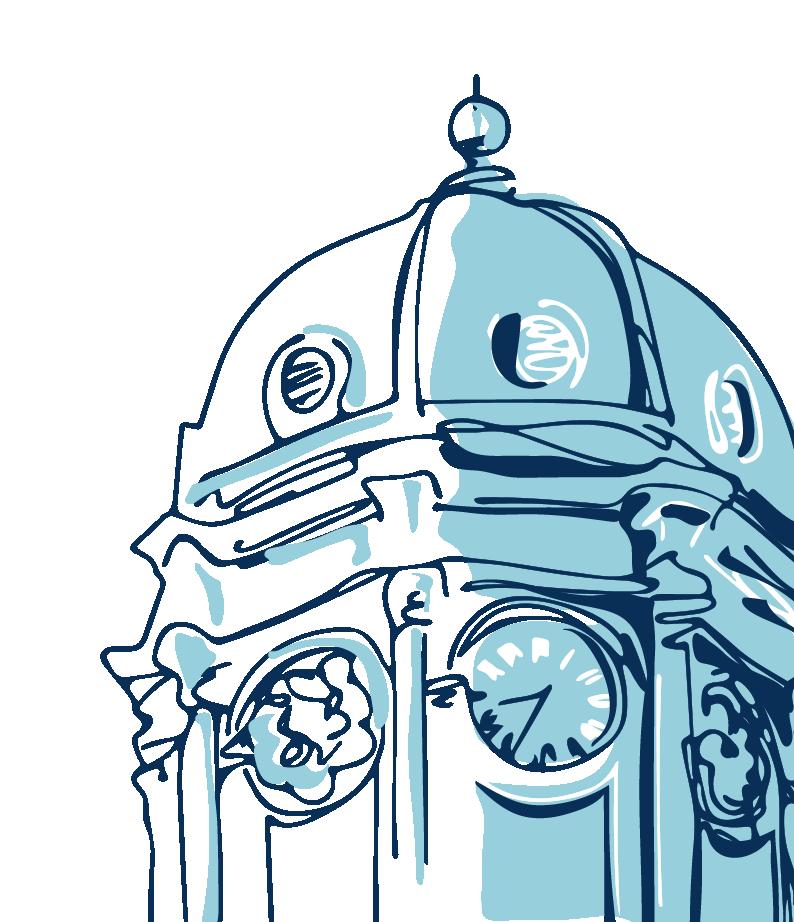
41 minute read
Top Issue: Streetscape
TIMELINE Long Term Consider Contacting a Public Private Partnership Specialist
(More than
four years) Using the powers granted to downtown development authorities, many Georgia cities, including Albany, have successfully utilized public–private partnerships to redevelop formerly vacant or underutilized downtown properties. Often, these complex deals are developed with the assistance of outside legal professionals specializing in “P3” transactions. If the demand exists locally for the Hawkinsville Downtown Development Authority to actively develop downtown property, local leaders could consider consulting a legal advisor with experience crafting successful public–private partnerships.
LEAD: Ken Clark, Hawkinsville Downtown Development Authority
PARTNERS: Hawkinsville–Pulaski County Economic Development, City of Hawkinsville
POTENTIAL ACTION STEPS:
1. Identify a key project or site that could be developed. 2. Contact officials with the Albany DDA and other cities to learn from their experience acting as a developer. 3. Consult downtown development professionals at the Georgia Cities Foundation/Georgia Municipal Association. Seek advice and opinions about what it takes to be successful. 4. Research legal advisors and various P3 legal structures used by other entities. 5. If demand exists for the Pulaski County–Hawkinsville Development Authority to develop property, contact a P3 legal specialist. 6. Work with a legal advisor to draft the P3 framework. 7. Consult the city attorney. 8. If development is determined viable, move forward as a project developer.
Streetscape
PARKING & BEAUTIFICATION
ike a downtown’s buildings, a city’s streets and sidewalks help make the first impression of the community for visitors and residents. While many of downtown Hawkinsville’s sidewalks have been improved with attractive streetscaping and were often praised by public input participants, the city’s streets were a frequent topic in step one of the RSVP process. Commerce Street, downtown’s traditional commercial corridor, was cited by local residents for issues like heavy truck traffic, dangerous speeding, unsafe pedestrian crossings, and dangerous parking conditions. Citizens see these conditions as problems that must be addressed to grow downtown, support local businesses, and create the active local destination desired by residents.
Entering downtown from the east or west, Commerce Street widens to 60 feet, with four or more travel lanes ferrying vehicles quickly through and away from downtown. These features prioritize the travel of those quickly passing through downtown. Multiple travel lanes, excessive pavement width, and low traffic volumes create optimal conditions for speeding through the area, harming pedestrian connectivity and creating potentially dangerous conflicts for those who wish to park and patronize downtown businesses.
To address these issues, many local residents in step one of the RSVP process requested that Commerce Street go through a “road diet” to reduce unnecessary additional travel lanes, slow excessive speeding, and make room for accessible angled parking, all of which would create a more visitor-friendly downtown. Used throughout the country, road diets are simple but innovative roadway reconfigurations that improve safety, boost livability, and advance an area’s economic vitality. The primary objective of road diets is improving safety for all roadway users while increasing livability by creating a pedestrian-friendly environment. Often as simple as restriping roads to remove excessive travel lanes and including elements like on-street parking, road diets are among the most affordable ways to reconfigure a city’s existing streetscape to create the safe, inviting, and accessible environment desired by residents.
Although much of Commerce Street currently features parallel parking, the four-lane configuration is like having no parking at all for many residents. Due to traffic speeds that regularly exceed 45 mph, using the parallel parking spaces along Commerce creates dangerous potential conflicts for drivers maneuvering into parallel spaces, or reentering high-speed traffic. With an average daily traffic volume of 6,120–6,800 downtown, Commerce Street is significantly oversized for current demand. While posted speed limits are 35 mph along Commerce Street downtown, four travel lanes and the relative absence of other vehicles makes dangerous speeding commonplace.

Estimating that most vehicles are travelling at above the posted speed limit downtown, in a collision with a vehicle traveling 40 miles per hour, 9 out of 10 pedestrians would be killed.
The dense collection of businesses, parked vehicles, and pedestrians downtown make this area unsuitable and unsafe for travel speeds above 25 mph. Local leaders should continue to work with GDOT to reduce posted travel speeds to 25 mph or lower in the downtown area. Doing so now may save lives in the future.
Lower traffic volumes and the high density of merchants and pedestrians along Commerce Street make this key downtown corridor an ideal candidate for a road diet with traffic-calming measures. The long-term vision for Commerce Street is to downsize from four lanes to two 11- to 12-foot lanes, which would allow properly sized angled parking on both sides of Commerce Street. Traffic-calming measures designed to improve pedestrian safety, reduce traffic speeds, and improve aesthetics help create a sense of arrival and encourage the vibrant downtown destination desired by local citizens. Hawkinsville has already been proactive by installing wide brick-patterned sidewalks along Commerce Street downtown. Working to incorporate angled parking and expand landscaped bumpouts would help to further calm traffic, reduce speeding, beautify downtown, and enhance pedestrian safety and connectivity.
As Commerce Street is a state highway, local leaders must continue their work with GDOT to pursue any significant improvements along the corridor. As part of this planning effort, planners and designers at the Carl Vinson Institute of Government collaborated with the city, county, and GDOT to create updated striping plans for Commerce Street. Following GDOT input and an in-person site visit by GDOT officials, local engineer Lance Woods of Ocmulgee Consulting Engineers revised the plans created by Institute of Government design staff to reflect site conditions and GDOT requests. Current striping plans for Commerce Street show the four travel lanes reduced to two travel lanes with the addition of a central turn lane and 5-foot bike lanes on both the east- and west-bound sides of Commerce Street. While an improvement over existing conditions, the center turn lane prevents angled parking from being included in these plans. Although these plans meet GDOT requirements and improve the corridor, to achieve the community’s long-term vision of Commerce Street, Hawkinsville leaders should continue working with GDOT to incorporate angled parking, midblock crosswalks, and expanded traffic-calming measures along the Commerce Street corridor.
Traffic Calming & Road Diets
Both traffic-calming measures and road diets are effective means of improving vehicular and pedestrian safety while guaranteeing more equal access to roads for all users. Road diets alter a corridor’s existing striping to reduce travel lane width or reconfigure travel lanes to create dedicated on-street parking, bicycle lanes, or other features. Traffic-calming devices like planted bump-outs, raised pavement areas, and parking treatments visually break up uninterrupted streets. Particularly in areas with significant pedestrian activity, implementing a road diet and traffic-calming measures can help ensure public safety and improve the experience of visiting downtown. Vehicles traveling at high speeds are particularly dangerous in downtown areas with significant pedestrian activity.
According to the National Highway Traffic Safety Administration, “as vehicle speeds rise from 20 mph to 40 mph, the likelihood of pedestrian fatality in the event
A five-year evaluation of traffic-calming measures cited by the Federal Highway Administration (FHWA) found the following:
• Little change in overall traffic volumes • A reduction in average vehicle speeds by almost 50% • An average increase in vehicle trip time of only 33 seconds • Traffic-calming evaluations uniformly show fewer crashes, fewer fatalities, and less severe injuries when collisions occur.
of a collision rises from 5% to 85%.” Safety studies show that shrinking oversized roadways can lead to an expected crash reduction of 19–47%.



EXISTING CONDITIONS Commerce Street’s excessive pavement width and unnecessary additional travel lanes encourage speeding along this main downtown corridor. Currently, Commerce Street features parallel parking. Many business owners and locals favor replacing parallel parking with angled parking to improve access. With few street trees and little shade, walking along Commerce Street can be uncomfortable many months out of the year. This corridor also lacks consistent pedestrian crossings and signals.


EXISTING | Commerce Street’s excessive pavement width and lack of shade discourage visitors from spending time downtown.
PROPOSED, FIRST STEP | Restriping crosswalks and planting Natchez crape myrtles in existing beds would help improve this key corridor. GDOT plans for Commerce Street include 5-foot bike lanes and a central turn lane as shown.
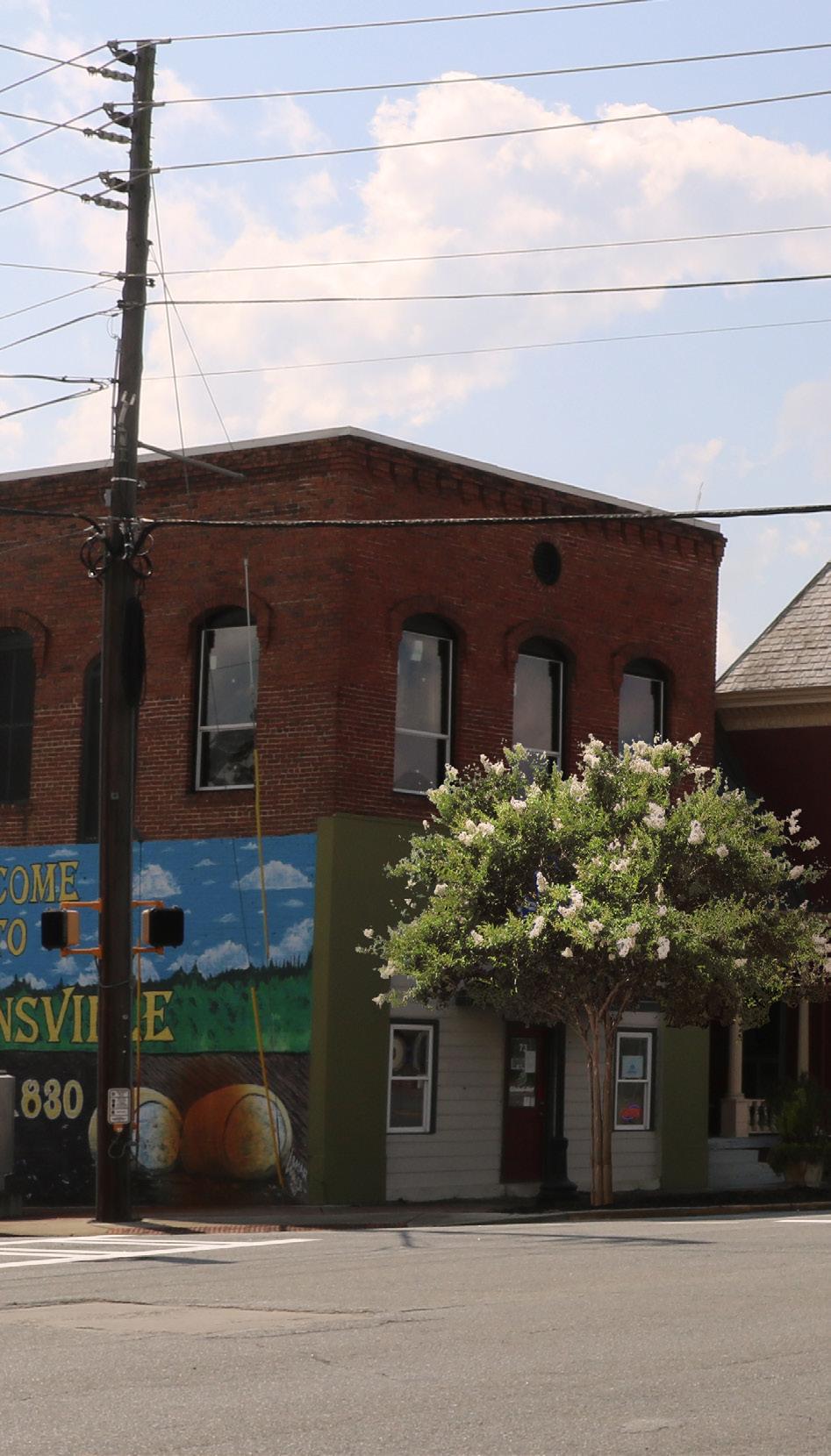
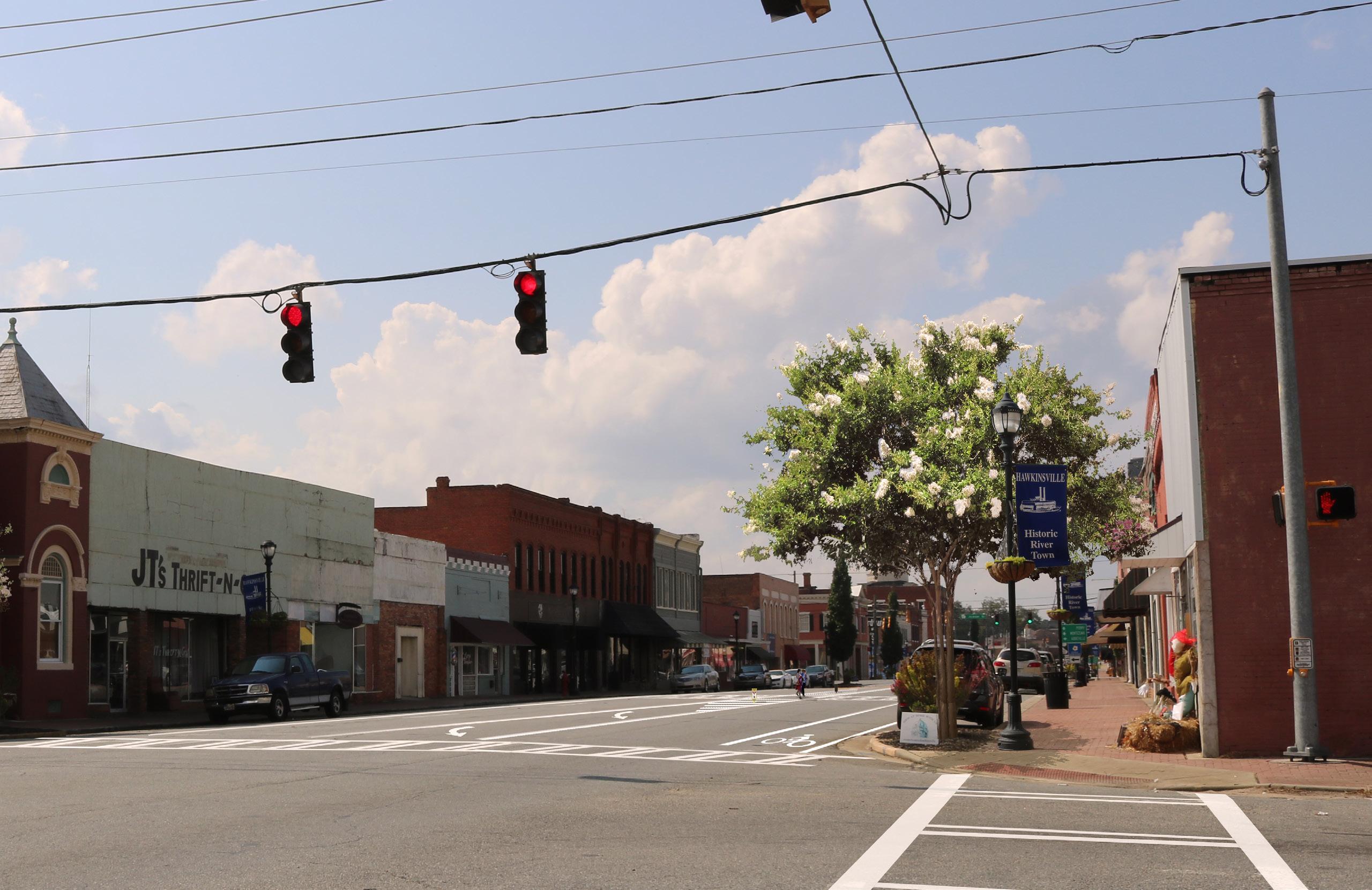
PROPOSED Eventually incorporating a protected pedestrian island into GDOT plans for Commerce Street could improve pedestrian safety and create planting beds to beautify the corridor.


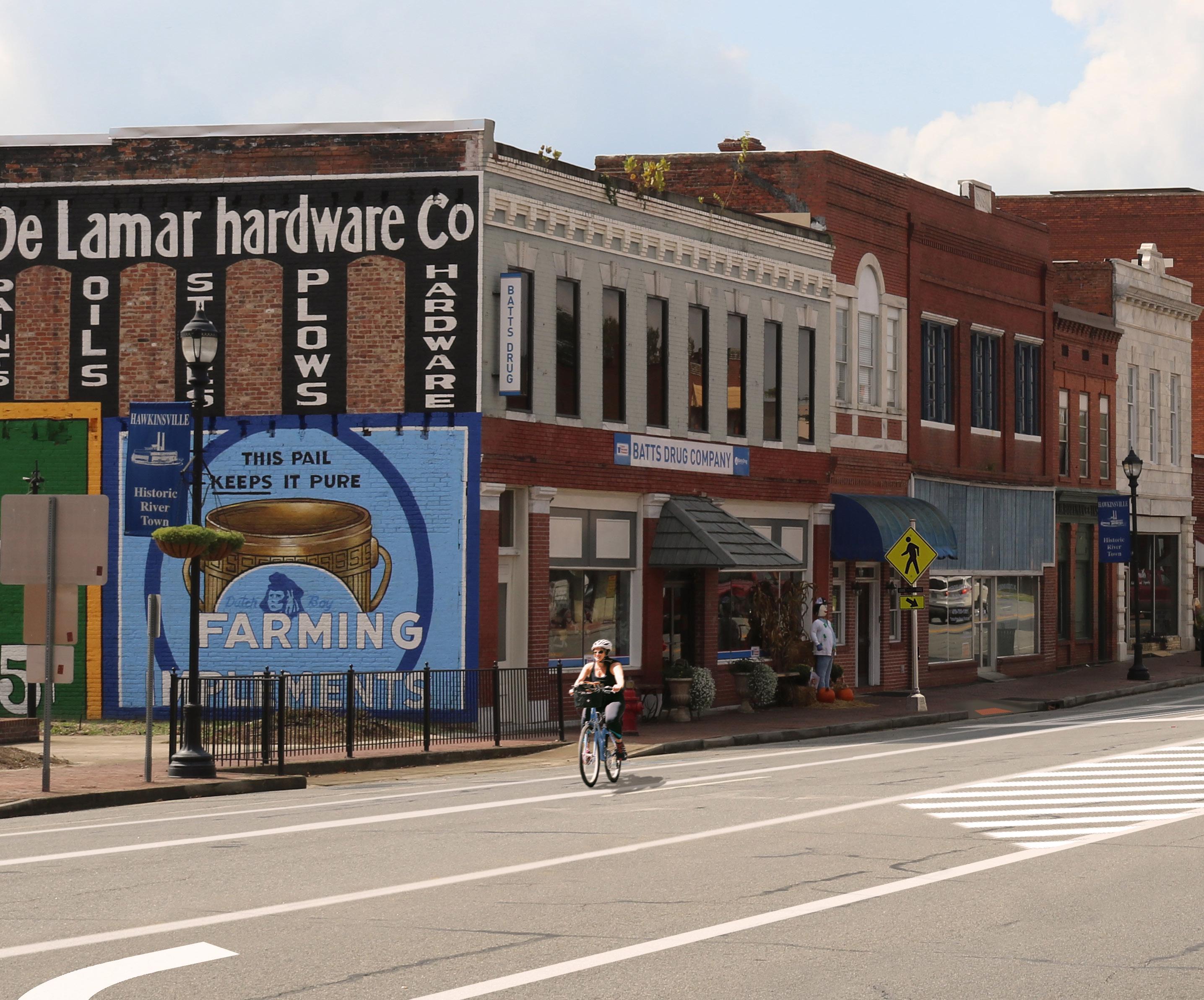

EXISTING | This photo shows Commerce Street between Jackson and Lumpkin Street in the center of downtown.

PROPOSED, STEP ONE | Working with GDOT to restripe Commerce Street in the near future, local leaders could request a midblock crosswalk to improve pedestrian safety downtown. This crosswalk shows rectangular rapid-flashing beacon (RRFB) signage, as requested by GDOT.


PROPOSED Working to incorporate a pedestrian refuge island into this design would further protect pedestrians and beautify Commerce Street.


EXISTING | The historic Pulaski County Courthouse at the intersection of Lumpkin and Commerce Street is an important destination and local landmark downtown. This intersection lacks a safe pedestrian crossing.
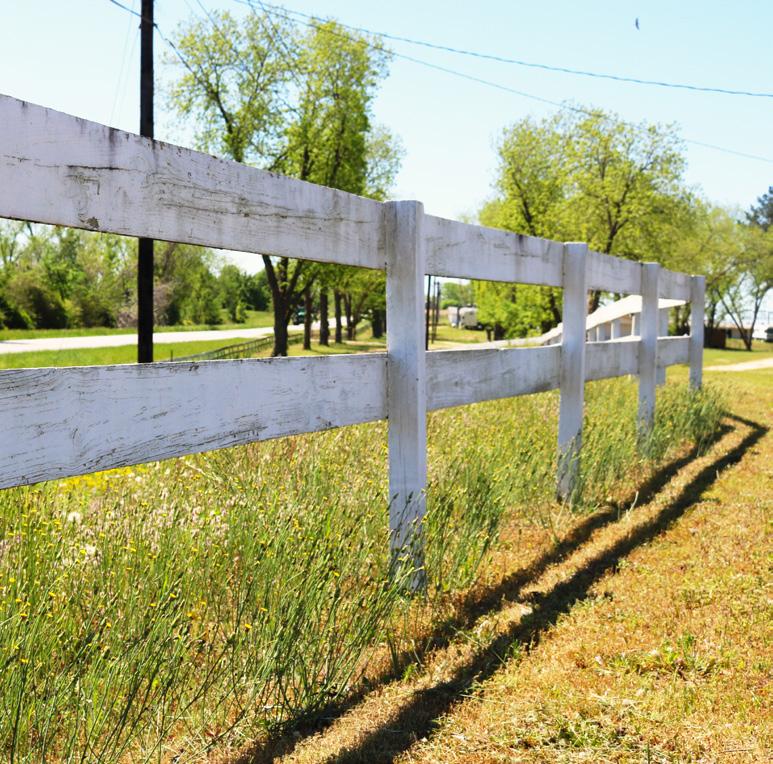

PROPOSED Including a crosswalk when GDOT crews restripe Commerce Street would improve pedestrian connectivity downtown. Planting crape myrtles in existing planting beds would help create a sense of arrival downtown.

EXISTING | This image shows Commerce Street in front of the former Taylor Memorial Hospital. Plans for this section of Commerce Street include an unusable 300’+ striped area in the proposed center turn lane.

PROPOSED | Existing plans for Commerce Street at the current Taylor Village development include angled parking and two 5-foot bike lanes as well as reducing four travel lanes to two travel lanes with a center turn lane. This image shows how incorporating a vegetated median in the 300-foot striped area could change the look and feel of this area. Planted with Natchez crape myrtles, this median helps create a sense of arrival downtown.

As heard repeatedly from small business owners and public input participants, reintroducing angled parking throughout the downtown core is desired. This significant redesign would benefit the entire downtown and dramatically increase the number of parking spaces and the ease of entering and pulling out of on-street parking spaces. In particular, angled parking has the ability to This circa 1950 image of Commerce Street downtown shows a bustling commercial district. Angled parking on both sides of the road help transform Commerce Street from an support the variety of businesses shown. Attractive lighting draped arterial vehicular corridor prioritizacross the street creates a special ambiance and memorable experience for downtown visitors. ing through-traffic into a local road serving the community and supporting downtown By prioritizing a return to angled parking and businesses. Historical photos of Commerce Street working to include traffic-calming features like in the 1950s show a bustling variety of downtown landscaped bump-outs and street trees, today’s local businesses with at-capacity angled parking on both leadership can help restore downtown as the heart sides of the road. These images also show string and soul of the community and bring this vision of lights draped across the busy street from the Hotel a bustling downtown to life. Hawkinsville and other buildings, creating a special Commerce Street’s name says it all — it is the ambiance that establishes downtown as a destina- primary commercial corridor and the economic tion. In essence the long-term proposed vision is heart and soul of downtown Hawkinsville. As a return to a tried-and-true historical downtown indicated by the input of community members streetscape. As proposed, 19.5-foot-deep angled from across Hawkinsville, encouraging a downparking helps create an important buffer between town renaissance and supporting redevelopment moving vehicles and the sidewalk. This additional in the commercial district is essential for the longspace makes pedestrians feel safer, buffers some term health and stability of the community. This of the noise from vehicles, and helps create the goal necessitates the reconfiguration of Commerce type of ambiance appropriate for vibrant street- Street from the old hospital block to the newly level dining and other uses. At the same time, the envisioned Veterans Park. As detailed in the plans 19.5-foot setback required for 45-degree angled and renderings that follow, these concepts enviparking can help reduce unsafe pedestrian cross- sion Commerce Street as a bustling and attractive ing distances and create the space necessary for downtown corridor, with accessible on-street angled landscaped bump-outs with street trees. Historical parking, wide bump-outs with large-canopy street photographs speak to the kind of vibrant down- trees, safe pedestrian crossings, and more. With town destination desired by modern Hawkinsville these improvements, Commerce Street can become residents. Angled parking, appropriate lighting, and the catalyst necessary for downtown redevelopment. safe streets for pedestrians and visitors are important elements of that vision.

EXISTING | Moving west from the new bridge, Commerce Street widens to over 60 feet, encouraging large trucks and other vehicles to pick up speed as they enter downtown.

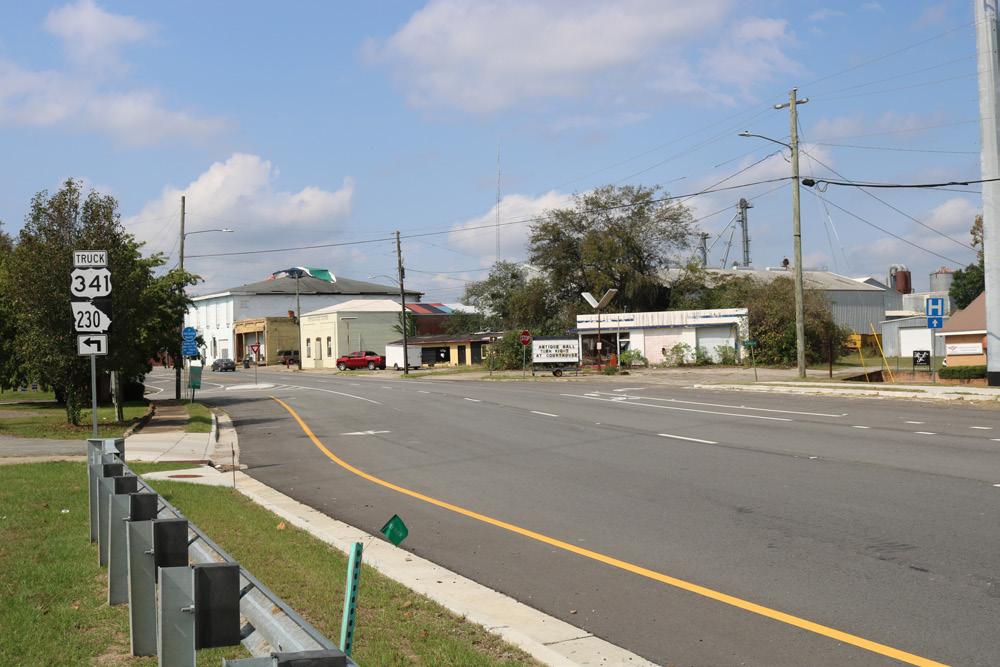
PROPOSED | Reducing excessive pavement width and removing unnecessary additional lanes could create the opportunity to install 5–8-foot vegetated medians. Shown with Natchez crape myrtles, these medians bring more color to the streetscape, help slow speeding traffic, and create a sense of arrival. This rendering also shows a welcoming downtown banner that uses Hawkinsville’s community brand.
EXISTING | Commerce Street’s excessive pavement width and lack of shade, together with the absence of street signage, discourage visitors from spending time downtown.


PROPOSED | Reducing excessive pavement width and removing unnecessary additional lanes could create the opportunity to return angled parking to Commerce Street. This rendering shows the four travel lanes replaced with two 12-foot drive lanes and 45-degree angled parking on both sides of the street. Angled parking also allows for large planted bump-outs to be installed at intersections and midblock crossing areas, bringing much-needed shade downtown. This rendering also shows attractive mast-arm traffic signals, clearly marked street signs, and freshly striped crosswalks. These elements send the signal that visitors and pedestrians are safe and welcome downtown.

EXISTING | This photo shows Commerce Street between Jackson and Lumpkin Street in the center of downtown.

PROPOSED | This rendering shows two unnecessary additional travel lanes converted into two 12’ travel lanes and standard 19.5’ 45-degree angled parking serving downtown merchants and businesses. Removing these travel lanes could help slow excessive speeding along Commerce Street and encourage more heavy trucks to travel along Broad Street rather than through the heart of town. The midblock crossing in the center of the image incorporates large canopy shade trees and provides a safe, well-marked crossing area for downtown visitors. Converting parallel parking to angled parking between Houston and Lumpkin Street would create 98 parking spaces downtown, expanding existing downtown parking capacity by 20 spaces.

EXISTING | The historic Pulaski County Courthouse at the intersection of Lumpkin and Commerce Street is an important destination and local landmark downtown. This intersection lacks a safe pedestrian crossing.


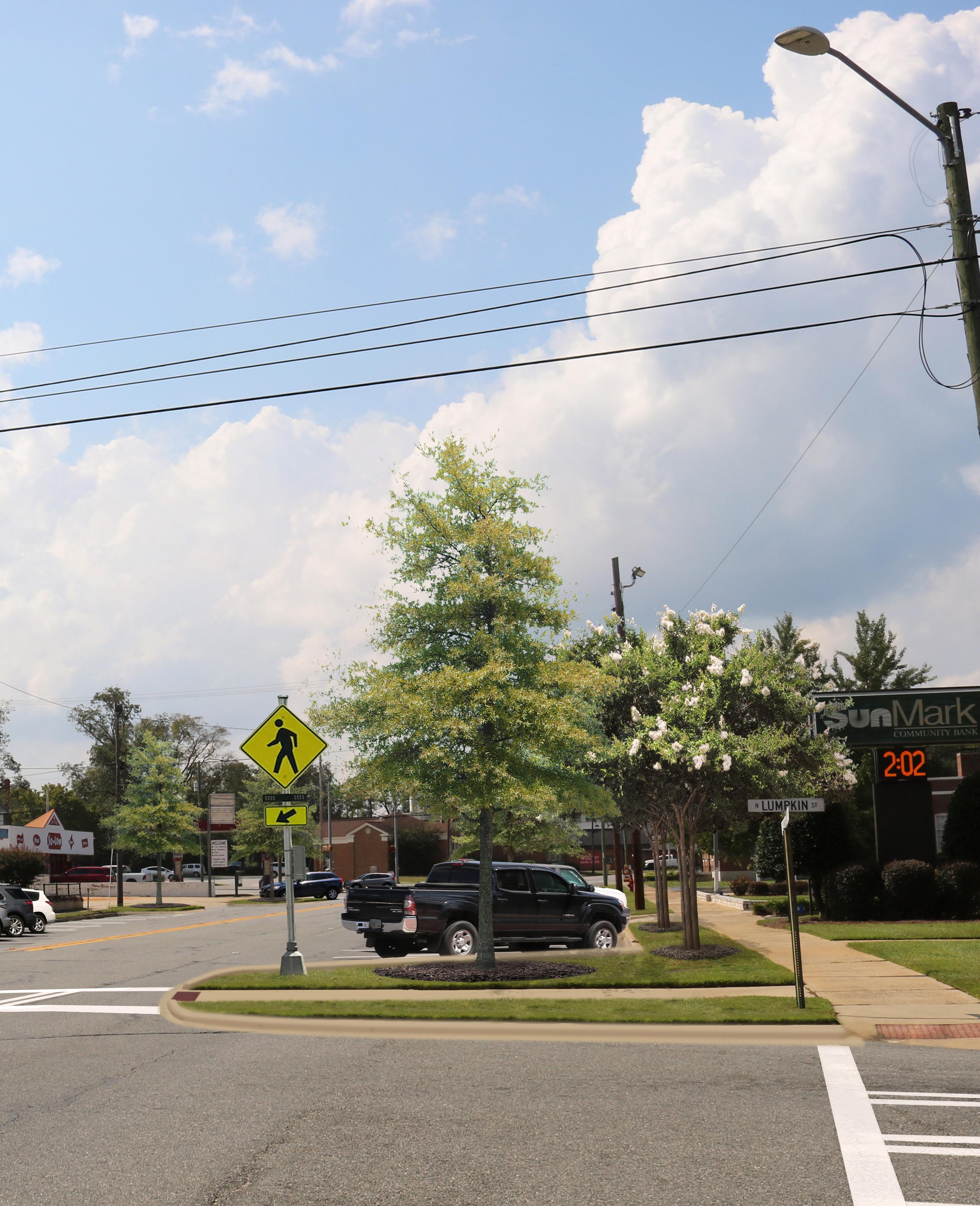
PROPOSED This concept includes a well-marked pedestrian crossing, landscaped bump-outs, and angled on-street parking. Extending angled parking between Lumpkin and Dooley Street would create 28 additional parking spaces downtown. Crape myrtles planted in existing tree lawns could create a welcoming sense of arrival downtown.
20-Year Vision

This plan shows Commerce Street transformed into the thriving center of a revitalized downtown Hawkinsville. As shown in previous renderings, this long-term vision restores angled parking downtown, improves rear parking areas, proposes sites for new development, expands parks, and improves the appearance of downtown with dozens of proposed street trees.

OTHER STREETS
After first focusing on improving Hawkinsville’s “main street,” in time local leaders should consider expanding improvements like on-street angled parking and landscaped bump-outs to major side streets including Lumpkin, Jackson, and Houston streets. Since many downtown side streets are locally controlled, the local government is able to install angled parking and other streetscape improvements along these roads as funding becomes available.
Broad Street, the primary vehicular corridor downtown, could also benefit from improvements like properly striped parallel parking areas, bump-outs to reduce crossing distances, and improved pedestrian crossings. Like Commerce Street, Broad Street features four travel lanes and a similar road width. While designed similarly, Broad Street carries roughly double the amount of daily traffic (13,200 daily trips) compared to Commerce Street. Broad Street’s status as a primary vehicular corridor makes this street a lower priority for improvement than Commerce Street or other downtown side streets; however, Broad Street could be made more inviting and safer for pedestrians over time. This corridor would especially benefit from as many GDOT-approved trees like Natchez crape myrtles as possible. Much of Broad Street already features 8–14-foot unplanted landscape beds. Largely within the GDOT right-of-way, installing approved trees like Natchez crape myrtles in these beds would help create a welcoming sense of arrival downtown and provide shade to pedestrians. At the same time, the city should work with property owners along Broad Street to plant large-canopy trees wherever possible outside of the GDOT right-of-way.
Hawkinsville could consider partnering with UGA Extension, the Georgia Forestry Commission, or other groups to organize a tree-planting campaign. Perhaps timed to coincide with Arbor Day or a local day of service, working with property owners to plant long-lived, large-canopy laurel, willow, Shumard, or other oaks along Broad Street could create an inviting canopy and transform the appearance of this corridor over time.

The plan for Florida Avenue includes elements proposed for Hawkinsville City Hall. Elements of the historic wall, arches, and tower on site are preserved and incorporated into the site plan. To slow speeding vehicles and encourage trucks to use Houston Street as a through street, this plan removes an unnecessary additional lane and incorporates pedestrian safety elements like expanded bump-outs and a raised midblock crosswalk connecting the city hall complex with the park. This concept also expands existing tree lawns and proposes both large- and small-canopy street trees to calm traffic and bring shade downtown. In this design, 45-degree angled parking is shifted toward Veterans Park, improving visitor access to the park and riverfront.

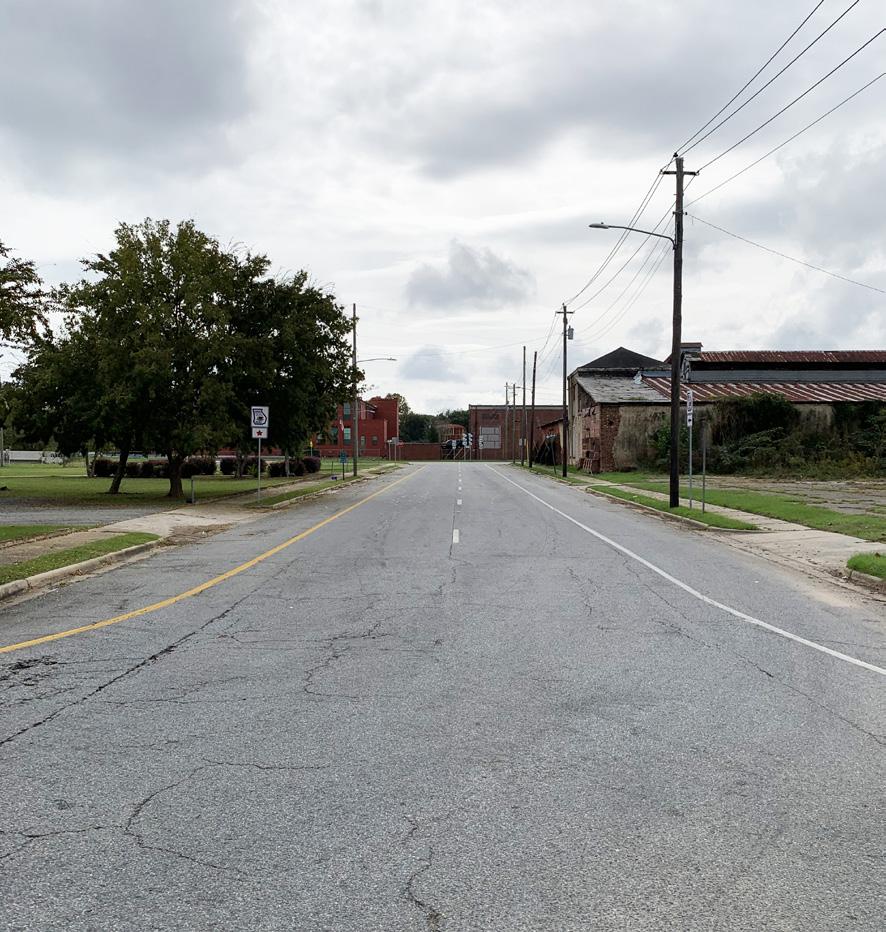
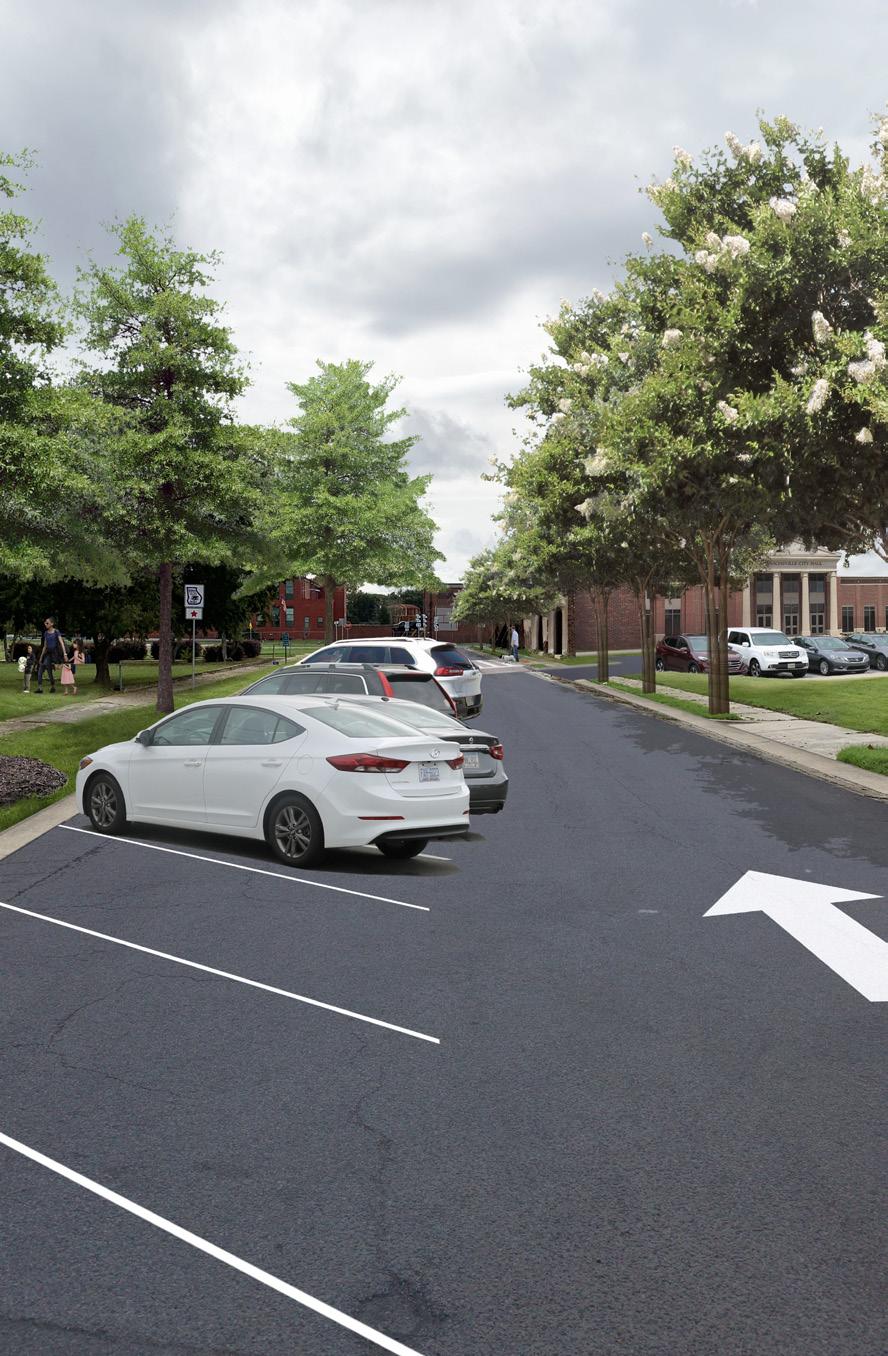
EXISTING | The two one-way travel lanes, excessive 42’+ width, and wide shoulders of Florida Avenue encourage dangerous speeds in this section of downtown. The road currently serves as a primary truck route between Commerce and Broad Street. Limited visibility and dangerous speeds make Veterans Park on the left of the image feel cut off from downtown.

PROPOSED | Removing an unnecessary travel lane could create additional parking for Veterans Park and reduce excessive speeding along this corridor. This proposed design for Florida Avenue includes pervious brick pavers. These pavers improve the appearance of the street, slow traffic, and allow for stormwater infiltration. A curbless design could allow this street to be closed off for events and festivals at nearby Veterans Park. This concept also expands tree lawns on either side of the street and incorporates both large-canopy street trees and flowering Natchez crape myrtles.

EXISTING | With over 70 feet of pavement width, Houston Street is significantly oversized for current demand.


PROPOSED This concept removes excessive pavement width to formalize angled parking on either side of the street and install large planted bump-outs at corners. Envisioned as the main truck route between Commerce and Broad streets, the generous southbound lane is a minimum of 15-foot wide.


PROPOSED | While maintaining Broad Street as a key vehicular corridor, improvements like installing Natchez crape myrtles in existing planting beds, repainting crosswalks, installing accessible pedestrian crossings, striping existing parallel parking, and adding attractive mast-arm traffic signals send the message that the community is invested in the appearance of downtown. Installing bump-outs where possible further enhances pedestrian safety and makes the existing on-street parallel parking more appealing.


EXISTING | This photo shows Broad Street looking east toward the Ocmulgee bridge, just past the intersection with Jackson Street.

PROPOSED | Natchez crape myrtles installed in the existing planting beds transform this into an appealing and inviting corridor. This rendering shows existing on-street parking formalized with striping and landscaped bump-outs. A proposed crosswalk in the distance marks the intersection with Houston Street at the proposed city hall site, improving access between downtown and the Cotton Mill Lofts development.

EXISTING | Across from the future site of Hawkinsville City Hall, Broad Street’s wide pavement width and unplanted landscape beds could be improved to create a sense of arrival .
PROPOSED | Incorporating Natchez crape myrtles in the existing planting beds could bring much-needed shade and help beautify the Broad Street corridor. This design also shows the existing on-street parking area formalized with striping, and it includes a new crosswalk at the Houston Street intersection. In areas outside the GDOT right-of-way, installing large-canopy oak trees could create an impressive shade canopy over time.

Tree Inventory
On city streets and throughout downtown, local residents agree that Hawkinsville needs more landscaping, street trees, and canopy cover. While bringing beauty, casting shade, and making downtown more inviting to explore, street trees have also been proven to slow traffic. Elements like street trees, bump-outs, crosswalks, and angled parking signal to drivers that they are entering a dense area and need to slow down. Slower vehicular traffic, in turn, encourages locals to walk to nearby restaurants and destinations, creating more visible activity and a more vibrant downtown for all users. From beautifying downtown to cooling sidewalks and slowing traffic, street trees offer an array of benefits for a low upfront investment. To encourage outdoor dining, cafes, and other vibrant outdoor spaces desired by the community, a shaded sidewalk is a must during the hot Middle Georgia summers. Longlived street trees make planting an investment that continues to pay dividends long into the future. As seen in the street tree inventory below, many downtown sidewalks feature empty bump-outs and tree wells with dead or missing trees.

Furthermore, many of the trees downtown are small-canopy crape myrtles that have been needlessly topped or severely pruned. Improper pruning, often referred to as “crape murder,” destroys the beautiful adult form that these trees are known for. Overzealous pruning of these otherwise graceful, low-maintenance trees results in a stubby and disfigured plant with no benefit to the community. As seen on Lumpkin Street, excessive pruning of these trees has led to many dead or gnarled crape myrtles, squandering this investment and making downtown feel further neglected. Moving forward, Hawkinsville should immediately halt this unnecessary practice and dedicate general funds and labor to planting new street trees in existing tree wells and bump-outs. For the greatest impact, Hawkinsville should consider investing in large-canopy, fast-growing street trees over small-canopy trees or labor-intensive, high-maintenance flowering shrubs, annuals, or perennials unsuited for the tough conditions of sunbaked planting beds and bump-outs. Species well suited to Hawkinsville include laurel oak (Quercus laurifolia), willow oak (Quercus phollos), Shumard oak (Quercus shumardii), London plane tree (Platanus × acerifolia), blackgum (Nyssa sylvatica), and more. Where utility lines or other conditions prohibit large-canopy trees, unpruned crape myrtles are a low-maintenance selection. To get the most benefits from these plantings, the city should select only the tallest cultivars, Natchez or Muscogee (Lagerstroemia ’Natchez,’ Lagerstromia ‘Muscogee’). In addition to stunning summer blooms, these trees can reach over 30 feet in height to provide shade to sidewalks and on-street parking areas.

Crape Murder
Among the most trouble-free and low-maintenance of landscape selections, crape myrtles are tough plants appropriate for many otherwise inhospitable conditions in downtown areas. With abundant blooms that offer a summer-long bouquet, a fine vase-shaped form, and handsome bark, these adaptable plants are among the most popular landscape trees throughout the South. Tolerant of drought, heat, bad soil, and pests, a crape myrtle can survive almost all conditions, with the exception of overzealous landscape crews. While common, the regular cutting back of crape myrtles does nothing to improve blooming, destroys the graceful form the crape myrtle is known for, and can permanently damage or kill the tree by inviting rot and disease to enter the plant. Improperly pruning crape myrtles, known as “crape murder,” prevents these otherwise attractive and long-lived trees from reaching their potential. Left unpruned, crape myrtles can achieve a graceful form that lends beauty to the streetscape. Superior cultivars like Natchez and Muscogee offer shade and year-round aesthetic appeal. Unfortunately, improper pruning of existing crape myrtles in Hawkinsville has left many of the city’s street trees disfigured. Local leaders should work with the local UGA Extension to educate maintenance crews and department heads to prevent unnecessary topping of crape myrtles and provide instruction in proper pruning techniques. While among the lowest maintenance landscape selections, crape myrtles can be selectively thinned to create single-trunked specimens and can benefit from the judicious removal of root suckers. UGA Extension agents could also consult local landscape crews on correcting years of improper cultural practices to restore Hawkinsville’s crape myrtles and allow these trees to grow and contribute to downtown over time. The UGA Extension publication Crape Myrtle Culture (Circular 944), included in the appendix of this document, outlines proper selection, planting, and care for crape myrtles.



PROPER CRAPE MYRTLE PRUNING TECHNIQUES
The following text was adapted from Southern Living’s “Stop! Don’t Chop Crape Myrtles!” by Steve Bender, published in August, 2008.
Objectives of Pruning
• Maintain the tree’s natural sculptural form. • Produce strong branches that hold flowers upright. • Thin dead or crossing branches to reveal the smooth, multi-toned bark that forms on mature trunks and branches. Cutting crape myrtles back to thick stubs each year makes these goals impossible. Ill-advised pruning can quickly turn a graceful tree into a fencepost or hat rack. With improper pruning, the crape myrtle’s beautiful exfoliating bark never appears, and each beheaded trunk grows a Medusa-like tangle of spindly whips too weak to hold up flowers.
1. Suckers coming up from the base 2. All side branches growing from the main trunks up to a height of at least 4 feet 3. All higher branches growing inward towards the center of the tree 4. All crossing, rubbing, and dead branches 5. Branches growing at awkward angles which detract from the tree’s appearance.
What to Cut
In late winter, with a focus on maintaining the overall form, remove branches in the following order:
Always cut back to a larger branch of the trunk; do not leave stubs. Removing seed heads on the end of branches is optional as leaving them does not reduce blooming next year.
Restoring a “Topped” Tree
If you have beheaded a crape myrtle to within a few feet of the ground, cut the plant completely to the ground. The tree should grow back very quickly. The next winter, select three to five well-spaced trunks, and cut off all others at ground level. Follow the instructions above, and you will have an attractive tree within five years. If you have a rounded off, or ”hat-racked” crape myrtle (cutting back all of its main branches to about the same height), then select two or three of the stronger shoots out of each branch to continue growing and prune the remaining shoots. Remove all new shoots that pop up and follow the instructions above to have a more natural-looking tree

EXISTING | Many tree grates along Lumpkin Street are unplanted, leaving this street looking neglected and in need of shade.

PROPOSED | Replacing empty tree grates or dead street trees with low-maintenance Natchez crape myrtles could improve the appearance of this street and bring much-needed shade.

EXISTING | This dead tree sends the wrong message to visitors along Lumpkin Street.
PROPOSED | Planting the existing tree grates with low-maintenance Natchez crape myrtles could improve this section of downtown.

Along with improving Commerce Street and working to create a canopy of downtown street trees, participants in step one of the Hawkinsville RSVP often voiced that downtown feels closed for business after 5:00. While providing visual interest and improving the perception of safety, lighting can help create an inviting atmosphere and encourage more activity after 5:00. Throughout downtown, working to repair existing street lamps and incorporate string lighting and other lighting options wherever possible can help address the view that downtown lacks evening activity. As seen in historical images of downtown, a variety of lighting, from neon marquees and signage to string lighting and streetlamps, helps create a unique visitor experience. Working with business owners to install and maintain a variety of downtown lighting could encourage the evening activity desired by the community and build the impression that downtown is a special destination.
In addition to beautifying downtown and addressing issues along Commerce Street, many


EXISTING | This photo shows a prominent broken streetlight and unplanted planting bed at Houston and Commerce Street. residents expressed the need to improve the condition, visibility, and accessibility of existing rear parking areas behind downtown businesses. Owned by individual merchants, these rear lots feel neglected. With a patched mismatch of paving, large potholes, a chaotic arrangement of back-of-house dumpsters and service functions, and the absence of landscaping, lighting, or striping, these rear lots make downtown feel unkempt. With only parallel parking on Commerce Street, the accessibility of these lots directly affects the health and stability of downtown businesses. Many first-time visitors are likely unaware of the large rear parking area behind businesses on Commerce Street. Improving lighting and installing signage directing visitors to these parking areas could help attract more patrons to downtown shops and restaurants. Working with property owners to beautify rear parking areas, including repaving, planting street trees, and consolidating service areas in interior parking lots could improve the appearance of these important resources, expanding community use and utility for business owners.

PROPOSED Replacing this street light and planting a large-canopy laurel oak in the bump-out makes this section of downtown feel well cared for.
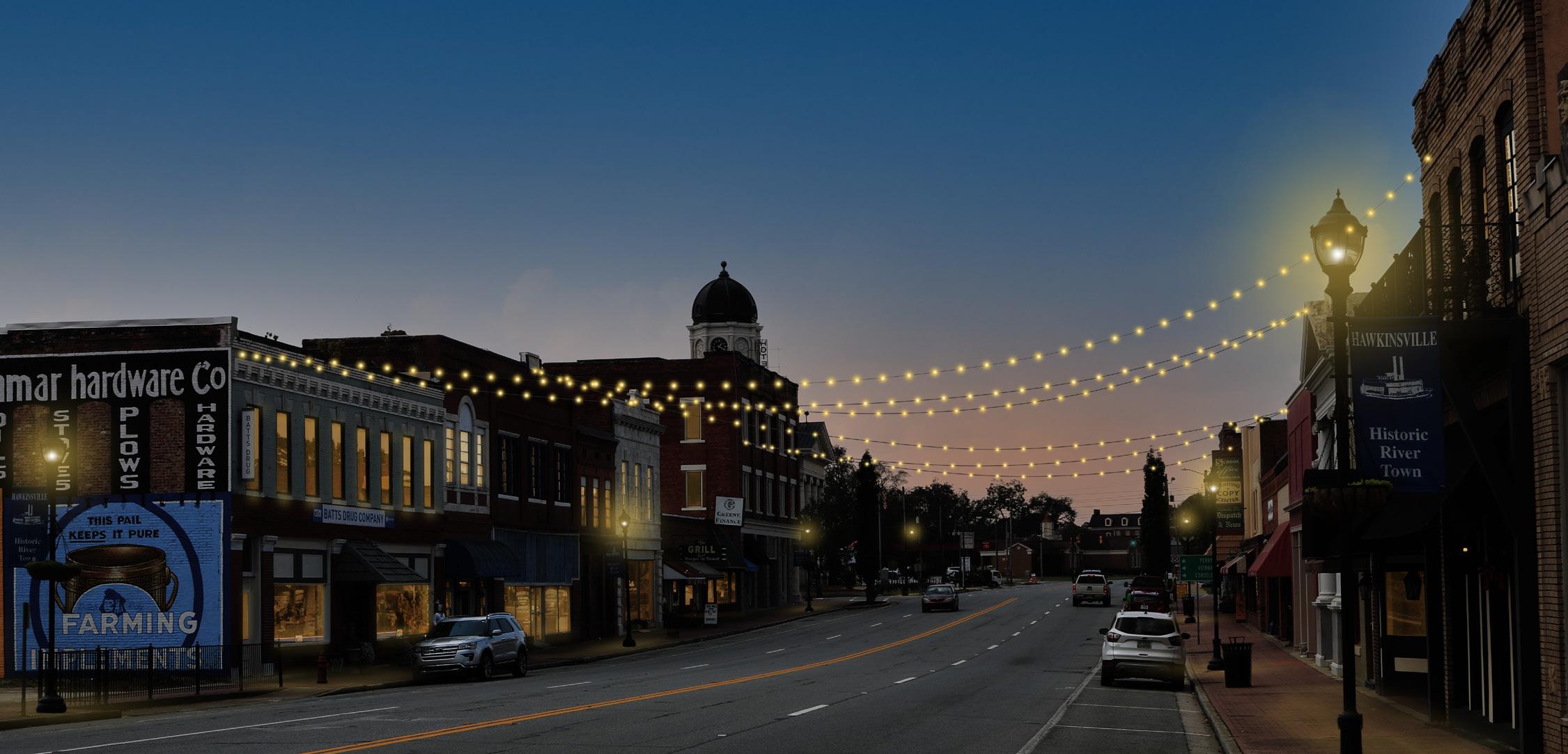
EXISTING | Commerce Street is the commercial heart of downtown Hawkinsville. Landscaping and attractive lighting could create a more inviting atmosphere downtown.
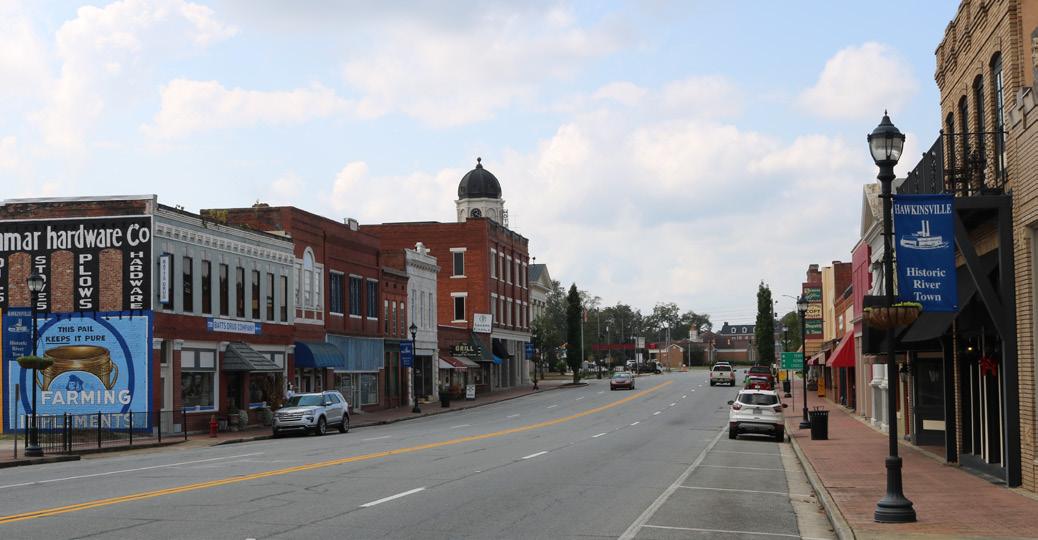
PROPOSED | Reminiscent of lighting seen in historical photographs of downtown, string lighting hung across Commerce Street could help create a vibrant and attractive destination. PROPOSED, OPTION II | Changing the color of LED string lights is often as simple as pressing a button. If desired, string lights could become brightly colored during the holiday season.



STEP I, MULCH

PROPOSED | Incorporating low-maintenance plants including Asian jasmine, Indian hawthorn, weeping rosemary, dwarf yaupon holly, and Chinese elm improves the appearance of this downtown park. This rendering shows movable stainless-steel cafe tables and chairs to replace broken seating and benches.



The soft glow of string lights gives Cabero Park a warm and inviting air, encouraging visitors to spend time downtown in the evening.


EXISTING | The impressive new murals at Cabero Park deserve to be shown off. This broken street light makes the park feel neglected.
PROPOSED Replacing this broken light would improve the appearance of the park and illuminate the new murals.

Action Items
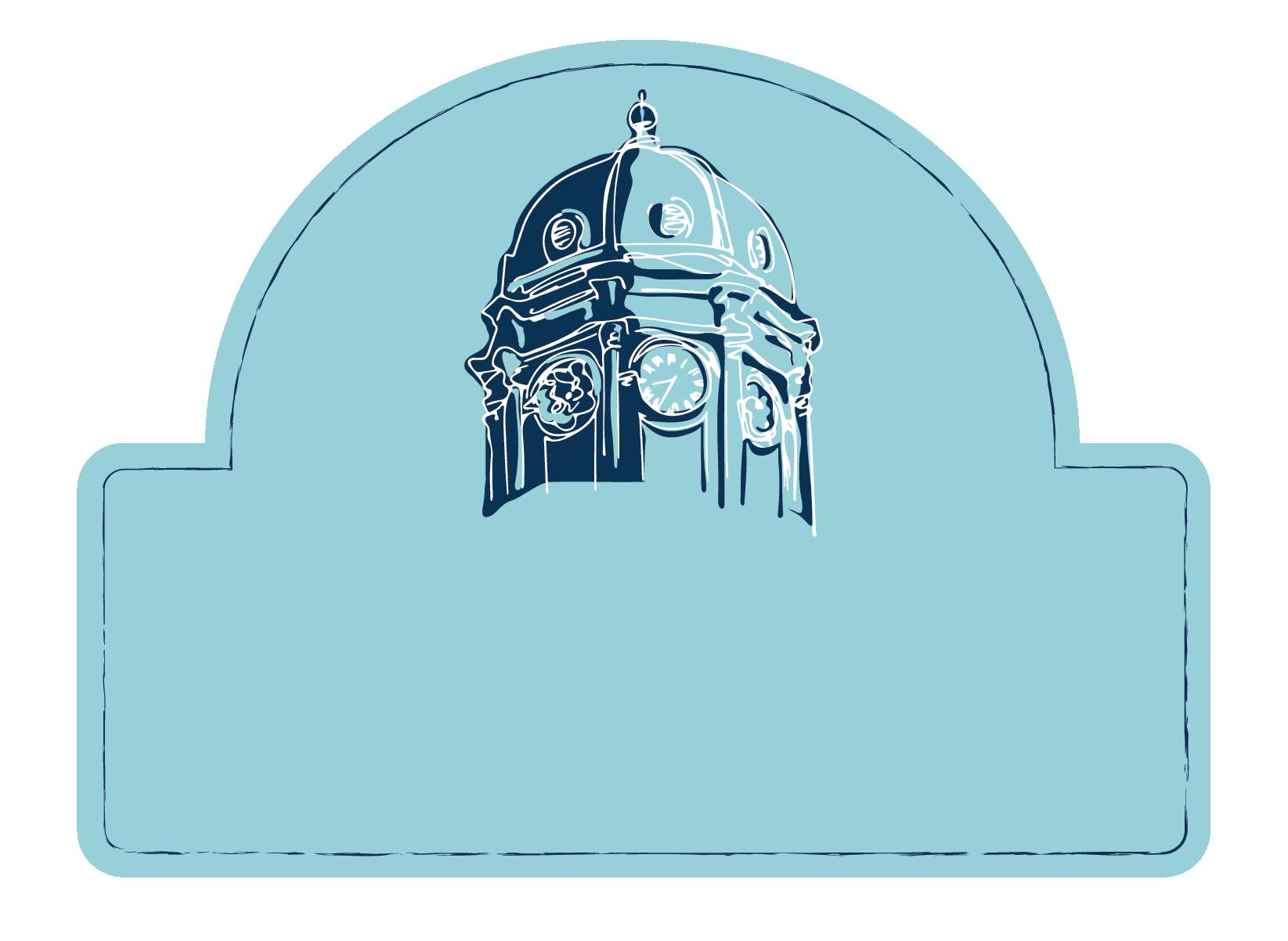
STREETSCAPE: PARKING & BEAUTIFICATION
TIMELINE Short Term (Six Months – Downtown Property Audit
Two Years)
To identify city and county properties in need of maintenance or repair, local leaders should conduct a block-by-block audit of all publicly owned property downtown. Participants should develop a list of needed improvements, including elements like missing street lights, sidewalks in need of repair, and more. Following the audit, local leaders should partner with Public Works or maintenance staff to make improvements. Promoting the results of these improvements after the fact would help build momentum for additional improvements. Replant Missing Trees
LEAD: Sara Myers, City of Hawkinsville PARTNERS: Public Works Department, Recreation Department, City Commissioners, Pulaski County POTENTIAL ACTION STEPS: 1. Contact relevant department heads, city commissioners, Pulaski County officials, and local leaders. 2. Select a time and date to conduct a block-by-block audit of downtown properties. 3. Conduct a property audit with local leaders, noting issues that must be addressed like broken streetlights, missing or dead street trees, faded or absent road striping, building repairs, failing sidewalks, and more. 4. Develop a master list of issues and provide the list to relevant department heads. 5. Work with city maintenance crews to repair issues found during the audit. 6. Publicize the repairs and the block-by-block audit in the Hawkinsville Dispatch and News, on the city’s website, and on social media platforms.
TIMELINE Short Term (Six Months – Two Years)
Following an audit of existing conditions downtown, local leaders should work to fund and implement replanting of dead trees or missing trees in downtown tree grates. While most existing street trees downtown are crape myrtles, Hawkinsville should consider replacing dead or missing trees with large-canopy street trees like laurel or Shumard oaks. Where crape myrtles are desired due to overhead lines or for trees located within the GDOT right-of-way, local officials should select either Natchez or Muscogee crape myrtles.
LEAD: Sara Myers, City of Hawkinsville PARTNERS: Public Works Department, Recreation Department, UGA Extension POTENTIAL ACTION STEPS: 1. Use a block-by-block audit of downtown properties to identify dead or missing street trees. 2. During the block-by-block audit, note unplanted bump-outs, tree grates without trees, dead trees, and unplanted landscape strips. 3. With the results of the audit, identify the quantity and types of trees needed. 4. For areas without overhead lines, select large-canopy street trees; for areas with low overhead lines, select Natchez or Muscogee crape myrtles. 5. Reach out to local nurseries and contact the Public Works Department to determine availability. 6. Consider consulting UGA Extension for advice on planting techniques and appropriate times to plant. 7. Where necessary, work with city maintenance crews to grind stumps from dead trees. 8. Work with city maintenance crews to replant missing trees.
TIMELINE Short Term Repair or Replace Broken Streetlights
(Six Months –
Two Years) A number of street lights in downtown Hawkinsville are noticeably damaged. Like blighted property, these broken streetscape elements send the signal that the community does not care about downtown. During the block-by-block audit, local leaders should note any visibly broken street lights. Local leaders should return in the evening hours to make note of any burned-out street lights. With the information gathered, local leaders should work with maintenance staff to repair or replace broken streetlamps downtown. Downtown Clean Up
LEAD: Sara Myers, City of Hawkinsville PARTNERS: Public Works Department POTENTIAL ACTION STEPS:
1. During the block-by-block audit, note any visibly broken street lights. 2. Return in the evening hours to note any burned-out lights or street lights in need of repair. 3. With the results of the audit, meet with city maintenance crews to determine necessary materials for repair. 4. Order replacement parts or fabricate them locally as necessary. 5. Work with city maintenance crews to repair and replace street lights.
1. Contact the relevant department heads, city commissioners, and local leaders. 2. Reach out to potential volunteers, including Michael King. 3. Select a time and date to hold a downtown cleanup event. 4. Invite photographers and press from the Hawkinsville Dispatch and News and elsewhere to cover the event. 5. Gather supplies and consider reaching out to merchants for donations. 6. Hold a downtown cleanup event. 7. Publicize the downtown cleanup on the city’s website and social media platforms.
TIMELINE
Short Term (Six Months –
Two Years) Like broken windows and peeling paint, litter sends the message that an area is uncared for and not worth investing in. During the public input process, residents described parts of downtown as dirty. Locals and visitors alike want to spend time in areas that are clean and feel cared for. Clean streets, parks, and sidewalks all send a message that a community is proud of downtown. Local officials and civic groups must prioritize cleaning up downtown Hawkinsville. Local leaders could consider partnering with volunteers and city staff for a downtown cleanup event on Earth Day or another day of service. Over the long term, providing adequate numbers and funding of maintenance crews is an essential step in ensuring that visiting downtown is a clean and attractive experience. Only when downtown feels worth investing in will the city be able to attract the new restaurants, businesses, housing options, and employers desired by the community.
LEAD: Sara Myers, City of Hawkinsville PARTNERS: Public Works Department, Recreation Department, Volunteers POTENTIAL ACTION STEPS:
TIMELINE Short Term (Six Months – Stop Pruning Downtown Crape Myrtles
Two Years) Regular topping of crape myrtles leads to ugly, disfigured trees with limited appeal. On top of being harmful to these trees, this practice takes time and resources away from necessary maintenance. Hawkinsville officials should immediately halt unnecessary pruning and contact maintenance crew members to request they stop pruning crape myrtles downtown. To help guide proper care of crape myrtles, the UGA Extension publication “Crape Myrtle Culture” is included in the digital appendix of this document. Local leaders could consider reaching out to the local UGA Extension office for additional information on the proper care and treatment of crape myrtles and other street trees. Extension agents may be able to assist the city with developing a maintenance schedule and instruct crews in proper pruning techniques and information on how to restore previously topped crape myrtle trees. Cabero Park Replanting
LEAD: Sara Myers, City of Hawkinsville PARTNERS: Public Works Department, UGA Extension POTENTIAL ACTION STEPS: 1. Contact city maintenance crew members to halt the pruning of downtown street trees. 2. Hold a meeting with maintenance crew members and a local UGA Extension agent. 3. Request additional information on restoring topped trees and other advice from the UGA Extension. 4. Consider working with UGA Extension to develop a maintenance schedule and help define procedures for the care of downtown street trees. 5. Following storm damage, natural events, or as circumstances require, prune trees as necessary following defined maintenance procedures.
TIMELINE Short Term (Six Months – Two Years)
Home to the Chero-Cola mural recently restored by students from UGA’s Lamar Dodd School of Art, Cabero Park and public spaces like it help bring life and visual interest downtown. Unfortunately, demolition of a wall over the past year or so required the removal of attractive plants and vegetation at the park. The city is developing plans to replace these plantings and restore Cabero Park as a downtown showpiece. Following the development of these plans, local leaders should work with local maintenance crews to replant the park with low-maintenance trees and plants. In this small but prominent downtown site, new plantings would be a low-cost, high-impact project. Replanting could also easily be a community volunteer project on Arbor Day or another day of service. If desired, local citizens could provide donations to plant memorial trees at Cabero Park or elsewhere downtown.
LEAD: Sara Myers, City of Hawkinsville PARTNERS: Public Works Department, Volunteers, UGA Carl Vinson Institute of Government, UGA Extension POTENTIAL ACTION STEPS:
1. Consult UGA designers and renderings in the RSVP plan for appropriate plant selection and the quantity of plants needed. 2. Contact UGA Extension for additional advice and suggestions. 3. Reach out to local nurseries and contact the Public Works Department to determine availability. 4. Consider reaching out to potential volunteers or citizens interested in donating support for replanting. 5. Work with city maintenance crews or volunteers to replant the park. 6. Invite photographers and press from the Hawkinsville Dispatch and News and elsewhere to cover the park replanting. 7. Consider working with UGA Extension to develop a maintenance schedule to define procedures for continued maintenance of plants in Cabero Park.
TIMELINE Short Term Install String Lighting
(Six Months –
Two Years) Lighting helps signal that an area is safe and inviting in the evening hours. To help spur evening activity, local leaders should work to install string lights and other attractive lighting along city streets and in public spaces like Cabero Park. Creative lighting could help establish an inviting atmosphere, showcase the existing murals at the park, increase the perception of safety, and encourage more evening patrons at downtown restaurants and businesses. MOU for Rear Parking Improvements:
LEAD: Sara Myers, City of Hawkinsville PARTNERS: Public Works Department POTENTIAL ACTION STEPS:
1. Conduct a walk-through of the park with a tape measure to determine the quantity of string lights needed. 2. Work with city maintenance crews to acquire and schedule installation of string lights. 3. Work with city maintenance crews to install string lights.
1. Contact individual property owners surrounding the rear parking area at Sioux Place. Supply information on how an MOU would work. 2. If property owners are in agreement, organize a meeting to go over details. 3. Consult the city attorney about creating a viable MOU. 4. Work with the Hawkinsville–Pulaski County Chamber of Commerce and the city commission to dedicate funding to rear parking area improvements. 5. Using the design supplied in the RSVP report as a starting point, reach out to local contractors, engineers, or other professionals for assistance creating construction documents. 6. Research the requirements and specifications of the EPA’s 319 Grant Program for States and Territories. 7. Consider applying for grant funding if appropriate. 8. Work with the selected contractor to improve the rear parking area, including repaving, constructing planting beds, and installing sidewalks and lighting. 9. Following improvements, promote the project in the Hawkinsville Dispatch and News and on the city’s website and social media platforms.
TIMELINE Medium Term (Two – Four
Years) While Commerce Street is generally well-maintained, many of the “back-of-house” areas in downtown are unattractive. To become the destination that locals desire, all of downtown must adhere the same standards. Particularly at the large parking area at Sioux Place, local leaders should consider developing a memorandum of understanding (MOU) with property owners to improve the shared rear parking lot. While maintaining ownership, an MOU would allow individual property owners band together with the city to fund and implement necessary improvements like repaving, restriping, installing street trees, and more. This agreement could encourage business owners to work together to help address the appearance of shared rear parking areas by installing attractive dumpster and service enclosures, centralizing garbage collection and grease pits, reorganizing inefficient parking arrangements, and more. The addition of trees, rear sidewalks, and lighting could help transform these rear service areas into amenities for business owners.
LEAD: Sara Myers, City of Hawkinsville PARTNERS: City of Hawkinsville, Property Owners, City Attorney, City Commission, Hawkinsville–Pulaski County Chamber of Commerce POTENTIAL ACTION STEPS:
TIMELINE Medium Term (Two – Four Years)
Consider a Transportation Alternatives Grant (TAP) for Long-Term Commerce Street Improvements
In recent months, Hawkinsville and Pulaski County officials have worked with engineers from GDOT to propose improvements to Commerce Street from Warren Street to the bridge over the Ocmulgee River. With support from local engineers and planners at the Institute of Government, striping plans exist to show the possibility of converting Commerce Street to a two-lane road with angled parking on both sides of the street downtown. These plans were supplied to a local engineer, Ocmulgee Consulting Engineers LLC, to create GDOT-approved plans for the corridor. While these plans have since been adapted and no longer include angled parking, Hawkinsville should continue working with GDOT to implement restriping plans and create a safer Commerce Street corridor.
LEAD: Sara Myers, City of Hawkinsville PARTNERS: Public Georgia Department of Transportation, Pulaski County, Ocmulgee Consulting Engineers LLC, UGA Carl Vinson Institute of Government POTENTIAL ACTION STEPS:
1. Work with Ocmulgee Consulting Engineers LLC to continue adapting the striping plan for Commerce Street. 2. Contact GDOT representatives to review potential restriping plans. 3. Following the review by GDOT, make necessary changes and resubmit the striping plans to GDOT. 4. Continue to work with GDOT to restripe Commerce Street and incorporate features like midblock crosswalks and on-street parking.
TIMELINE Long Term (More than Four Years)
A program of the Federal Highway Administration (FHWA) administered in Georgia by GDOT, TAP grants can help local governments fund pedestrian and bicycle infrastructure. During the process of planning downtown streetscaping improvements, Hawkinsville officials should consider applying for TAP funding. To be eligible, project costs must exceed $1 million and include local matching funds. TAP funding can be used for engineering or design plans necessary for GDOT approval. Among other requirements, eligible projects must be beneficial to pedestrians or bicyclists, and should accomplish multiple goals, including traffic calming, beautification, and more. For additional information, see http://www.dot.ga.gov/IS/Funding/TAP#tab-4.
LEAD: Sara Myers, City of Hawkinsville PARTNERS: Georgia Department of Transportation, Pulaski County, Middle Georgia Regional Commission POTENTIAL ACTION STEPS:
1. Identify a key project like long-term pedestrian improvements along Commerce Street that could benefit from TAP funding. 2. Consult local leaders in Georgia cities that have successfully applied for and used TAP funding, including Greensboro, Georgia. 3. Work with the designated project lead to secure Local Administered Project (LAP) certification from GDOT, a prerequisite for eligibility. 4. Work with the city commission and Pulaski County to dedicate local funding to the project. 5. Seek design and planning assistance from local engineers, the UGA Archway Partnership, and elsewhere. 6. Put together an application and submit it to GDOT






